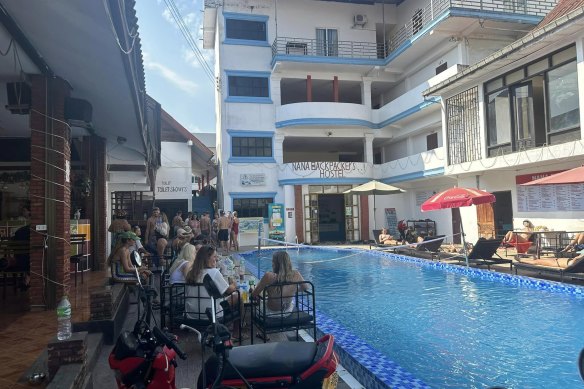By Liam Mannix
Two Melbourne teenagers are fighting for life and two people are believed to have died after consuming drinks containing methanol while holidaying in Laos.
The 19-year-olds from Melbourne’s bayside suburbs are believed to have been out drinking in popular tourist town Vang Vieng before they fell ill with suspected methanol poisoning.

The Nana Backpacker Hostel in Vang Vieng, Laos, where the Melbourne teens had been staying.
Methanol is a type of alcohol, but unlike ethanol – the key alcohol found in wine, beer and spirits – it can be lethal in small doses.
As little as 30 millilitres of methanol is enough to kill unless urgent medical treatment is received. Just two teaspoons can cause blindness.
Commercial breweries filter methanol out of their products. But home-brewed or fermented drinks can contain methanol.
Because it’s cheaper than ethanol, it’s often used in alcoholic beverages. Medecins Sans Frontieres has tracked almost 13,000 suspected deaths from methanol poisoning since 1998, with 394 deaths in the past 12 months – almost half of them in Indonesia.

Vang Vieng in Laos is popular with tourists.Credit: iStock
“This has been a particular problem in South-East Asia, where there are regular incidences of methanol poisoning,” says David Ranson, a recently retired specialist forensic pathologist at the Victorian Institute of Forensic Medicine in Melbourne.
“The actual chemical isn’t the problem. It’s the breakdown products.”
Small change, big risk
Alcohol molecules – there is a range of different ones – are made of carbon, oxygen and hydrogen atoms at different concentrations.
The difference between ethanol and methanol is one carbon atom, says Dr Ian Musgrave, a molecular pharmacologist at the University of Adelaide.
Ethanol has two carbon atoms. Methanol has one.
Both can be produced by fermentation using yeast, although methanol is typically made industrially, often for use in antifreeze or household cleaners. Both are colourless and have a similar smell, but methanol does not cause inebriation.
Ethanol and methanol respond very differently inside the liver.
Our liver is charged with breaking down the chemicals we consume. It breaks down alcohol using a group of enzymes called alcohol dehydrogenases.
When ethanol is broken down via this route, it first turns into acetaldehyde – a toxic but short-lived chemical – and then acetic acid, which we call vinegar.
When methanol is broken down by the liver, it first turns into formaldehyde, then formic acid.
Formic acid is highly toxic. It blocks the ability of our cells to make new energy – which is enormously damaging to the body, particularly in places where a lot of energy is being used, like the retinas behind the eyes.
Symptoms take six to 24 hours to emerge and include abdominal pain, dizziness, blurred vision and vomiting. While symptoms can at first be confused with a hangover, they can quickly progress into hyperventilation and blindness as the body enters a state of multi-organ failure.
“If you get treated early enough, you may do reasonably well,” says Ranson. “Once you get into multi-organ failure, you can have permanent blindness, permanent vision damage, permanent kidney damage.”
Without treatment, patients can end up in a coma. The mortality rate is between 20 and 40 per cent.
To avoid methanol poisoning, Medecins Sans Frontieres advises travellers to always stick to buying bottled, commercially produced alcohol from licensed premises or shops – and not to be seduced by the offer of cheap, homemade liquor.
Get fascinating insights and explanations on the world’s most perplexing topics. Sign up for our weekly Explainer newsletter.